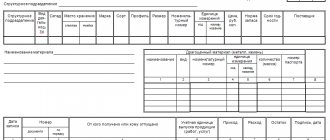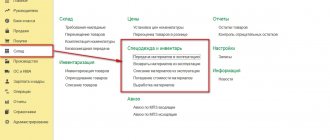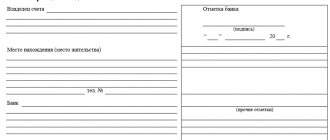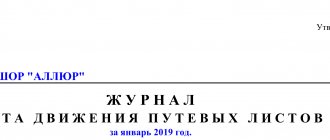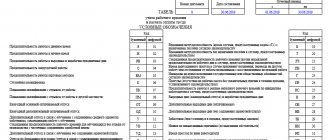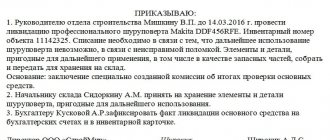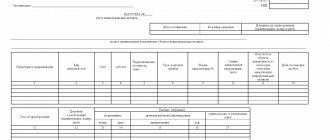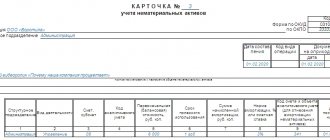What forms to use at work
Law No. 402-FZ “On Accounting” provides for the right of economic entities to choose the forms of primary and accounting documentation.
It is not necessary to use standardized forms. It is permissible to develop your own formats or modify approved documents. For example, supplement unified tables with sections and columns necessary to detail specific information about activities. Each company makes its own decisions. What forms to work on must be specified in the accounting policy. Otherwise, controllers may have questions about documenting accounting.
To systematize information about inventory items, it is permissible to use the unified form M-17 “Material Warehouse Card”. The format of the M-17 form was approved by Resolution of the State Statistics Committee of Russia dated October 30, 1997 No. 71a.
Current form: warehouse registration card M-17
General information about the materials accounting card
The form of the document was approved by Resolution of the State Statistics Committee of Russia dated October 30, 1997 No. 71a. A separate card is drawn up for each item number, and the financially responsible person is responsible for its maintenance. Entries in the card are made on the basis of primary documents.
Since 2013, maintaining this form is not mandatory. Organizations are given the right to develop their own forms, which must contain a list of details approved by law.
Form M-17 “Material Accounting Card” is also used to release materials to production from the warehouse in which they are stored. An appropriate entry about the movement is made in the document, certified by the signature of the responsible person.
Filling principles
The compilation of accounting cards should be carried out by an employee who is charged with such a duty. Responsibilities should be specified in job descriptions. The job description should not be a formal document hidden deep in the archives: the employee must read the document and sign confirming that he agrees with the wording.
Fill out accounting documentation based on the following requirements:
- Forms can be filled out by hand or on a computer. It is acceptable to use specialized programs for accounting.
- The organization's stamp on the card is not required - it refers to internal documentation.
- If errors are found in the form, corrections are made according to the general rules. An incorrect entry is crossed out with a thin line. The correct information is written next to it. The record is certified by the signature of the responsible person.
- The card is issued for one year. At the end of the period, a new form is filled out.
Documents from previous years must be submitted to the archives for safekeeping. The shelf life of accounting cards is at least 5 years.
Accounting for M-17 cards in the warehouse
The paper described is opened by the accountant for exactly one calendar year, and the warehouse manager may be responsible for filling it out. Closed documentation of the presented type is stored in archival structures for at least five years. During the entire mentioned period, the certificate is easily required by employees of various supervisory and regulatory authorities. The impossibility of presenting it is a direct road to problems, including those of a material, administrative and sanctions nature. Interaction with such forms is carried out on the basis of certain regulations:
- records are kept in the accounting department in a single, laced, numbered and registered journal;
- each documentary item is assigned its own unique identification number;
- entries in the statement are made exclusively on the day of business incoming and outgoing transactions;
- employees of the accounting department are required to conduct full or random checks, monitoring the filling processes;
- maintaining papers is also addressed to ordinary operators, but only with the permission of the responsible person.
Warehouse inventory cards for inventory items and materials can be found here.
Step-by-step instructions for filling out
Let's figure out how to fill out a materials accounting card. Step-by-step instructions for the M-17 form consist of 5 steps.
Step 1. Write down the number and date of the document.
Step 2. We indicate the name of the organization and enter the structural unit.
Step 3. Fill out the tabular part:
- column No. 1 - structural unit;
- column No. 2 - type of economic activity of the unit;
- column No. 3 - warehouse number;
- Column No. 4 and No. 5 - specifies the storage location of the material.
Then we indicate the characteristics of the accounting object. We register the brand, grade, profile, size and other information about the goods and materials. We enter the item number, unit of measurement, cost, price, inventory standard, expiration date and full name of the supplier. If there is no information, put a dash.
Step 4. The following table M-17 is information about the presence of precious metals or stones in the accounting asset. Fill in the appropriate positions in the table if the relevant information is available. Enter the data according to the passport of the tangible asset.
Step 5. The third table reflects information about the movement of inventory items within the organization. Fill in the information in the columns:
- “Record date” - enter the date of actual movement of the inventory asset;
- “Document number” - indicate the number of the primary document on the basis of which the movement is carried out - register the serial number of the operation;
- “From whom it was received or to whom it was issued” - enter the name of the organization or structural unit of the enterprise;
- Next, enter the unit of production of goods and materials;
- in the columns “Receipt”, “Expense” and “Balance” we write down the amount of goods and materials that were received, transferred or remain in storage. Records are recorded after each operation.
The last column is for the signature of the responsible employee. Be sure to indicate the date of the operation.
The completed warehouse accounting cards (sample M-17) are signed by the financially responsible person. Enter his position, full name, date of signing.
Material accounting card M-17, sample filling
Filling Features
A materials warehouse card is a unique kind of register that allows you to set up a simple and effective system of control over all received and sent inventory items. The storekeeper or warehouse manager is responsible for entering information into this form. He takes on his work, performing it only on the basis of all kinds of receipts, expenses and accompanying documents. Moreover, when preparing an extract for the first time (or for any new nomenclature item), the specialist may encounter all sorts of difficulties. The accompanying government regulations outline how to deal with the challenges of this bureaucratic level:
- If the cost of products supplied within the same batch differs, the table is simply changed by adding another column to it listing price characteristics.
- Materials accounted for in some units of measurement and released in others can be described using two attributes in a cell at once.
- If a product does not have an expiration date, a simple dash should be placed in the appropriate box.
In fact, there are a lot of such recommendations. The most convenient way to fill out the documentation in question is professional commercial software. For example, software from the Russian company Cleverence already includes all the necessary forms and detailed instructions for interacting with them. In addition, the branded modules “Warehouse-15” and “Magazin-15” are excellent for the widespread optimization of classic routine business processes.
Exceptions for state employees
Public sector institutions operate according to different rules and regulations. State and municipal organizations are required to use primary accounting documents approved by Order No. 52n.
Warehouse accounting cards (form for public sector employees) have OKUD code 0504043. They are used to reflect information about goods and material assets stored in the institution’s warehouses. The form provides for the disclosure of information about the type of inventory items, their location (structural unit), their accounting value, supplier and other details.
The primary document must be completed by the responsible employee. For example, an accountant responsible for accounting for inventory items in an institution. The form is convenient to use for small volumes of valuables in storage, since for each asset you will have to create a separate sheet of the inventory card (material assets accounting card).
Warehouse registration card form
Sample filling
Card for recording material assets in the budget
The card for recording material assets (OKUD 0504043), used in the public sector, was approved by Order of the Ministry of Finance of the Russian Federation dated March 30, 2015 N 52n. It is intended for accounting of inventory items available in the warehouse. The form contains information about the type and location of inventory items, their price, and supplier.
This form is used in government agencies that have a small amount of material assets. The document may consist of several sheets, since each individual asset must be allocated a separate sheet. Entries in the document are made by the employee responsible for storing valuables. The card should be certified with the individual signature of the responsible person with a transcript. You can download the card form below.
Registration of a warehouse registration card
It is fundamentally important that the preparation of warehouse documentation is assigned to the responsibility of a specific employee. The person responsible can be appointed by a separate management order. Include in your job descriptions statements about responsibility for the correct execution and safety of warehouse forms.
If necessary, prepare special instructions or a memo for maintaining documentation in the warehouse. Familiarize the responsible employee with the provisions of the instructions for signature. A subordinate will not be able to evade the tasks assigned to him.
Fill out the materials warehouse card taking into account the following recommendations:
- You can work using a self-developed template or warehouse accounting card. Fix the choice of form in the company's accounting policy.
- Warehouse inventory cards can be issued by hand or using a computer. Printed papers must be certified by the signatures of responsible persons and management.
- Maintaining documentation in electronic form is allowed. For example, using specialized accounting or accounting programs. Electronic registers require certification with a digital signature.
- It is not necessary to put the organization's stamp on the card. The form does not provide this information during registration.
- The use of corrective putties, tapes and other means is not permitted. The erroneous entry is crossed out and corrections are made nearby. The correction is certified by the signature of the responsible employee. The date and full name are placed next to it. and position.
- The form is opened for one calendar year. At the end of the period, a new document must be created.
Submit documentation from previous years to the institution's archives. The storage period for cards is 5 years from the end of the reporting period. Or five calendar years from the date of the audit.
Automation of warehouse accounting and the formation of traceability of inventory items
The following are accepted as inventory items:
- raw materials, materials and other assets used in the production of products (provision of services);
- finished products and goods;
- materials used in the process of performing work to ensure the normal technological process and packaging of products or spent on other needs (testing, repair and operation of equipment, buildings);
- spare parts for equipment repair and other material assets not classified as fixed assets;
- purchased components and semi-finished products that undergo additional processing or assembly at the enterprise, etc.;
- waste and defects.
As a rule, the listed material assets are stored in various warehouses. To ensure the operation of production, it is necessary to have information about the current location of each item of inventory and materials at a certain point in time in order to predict the timing and quantity of finished products, and deliver components on time. Figure 2 shows a typical diagram of the movement of inventory items at an enterprise.
The diagram shows that the main movements from material warehouses occur to production workshops, between workshops, from the finishing/assembly workshop to the finished product warehouse.
To register warehouse movements, the following documents are required:
- The materials accounting card (form M-17) is the main document that is used to control the movement of inventory items. The paperwork is the responsibility of the financially responsible employee.
- Receipt order (form M-4) - used to account for material assets coming from suppliers or from processing.
- Invoice for external release (form M-15) - is intended to record the supply of material assets to the farms of your organization located outside its territory, or to third-party organizations.
- Request-invoice (form M-11) is a document for recording the movement of material assets within the organization. Used to process interwarehouse movements, issue inventory items to production, and return unspent inventory items to the warehouse.
- Limit-fence card (Form M-8) - is used if there are limits on the supply of materials for the release of materials and is a supporting document for writing off material assets from the warehouse. It is used when the enterprise regularly transfers inventory and materials from one division to another.
Considering the variety of inventory items and the peculiarities of their movement, the production processes of any enterprise cannot be imagined without such an important warehousing tool as inventory accounting.
Warehouse accounting is of procedures documenting , such as: receipt of goods ( raw materials , supplies ) ; their placement in a warehouse, movement between warehouses (and other related departments); release of goods from the warehouse for one purpose or another (for shipment, for production); write-off
The main task of warehouse accounting is to control the availability, safety and movement of inventory items at the enterprise. In addition, it is warehouse accounting that allows you to classify inventory items depending on various parameters (expiration date, footage, weight, dimensions, batch number, etc.) and production needs.
At every enterprise, it is important to ensure the interaction of accounting and warehouse accounting. If you do not update information about inventory items in real time, discrepancies arise between the actual balances of inventories in the warehouse and those listed in the accounting database, for example, if the necessary items of components were sent from the warehouse to the production workshop, but the information in the database was not updated.
Traceability is the ability to track the history, use, or current location of an item in a warehouse by recording all changes in a production accounting system. With its help, you can control the movement of inventory items from receipt at the warehouse to the release of finished products. The traceability system helps to ensure control of all production processes and reduce enterprise costs and the cost of the final product, as well as reduce direct and indirect costs, reduce defects, and improve the production process.
The introduction of accounting in production is the first stage of inventory traceability. A significant difference between production accounting and “simple” warehouse accounting is that in it, inventory items are written off from the warehouse to production, and then finished products are created, the cost of which includes the cost of previously written off inventory items. This process is carried out according to certain rules, both from the point of view of accounting and from the point of view of production technology. From a technology point of view, the composition of the product and the sequence of technological operations are important. This is determined by the relevant design and technological documents. In addition, there is another feature of production accounting - the so-called work in progress. This is a collection of inventory items that have already been written off for production, but have not yet become finished products.
The implementation of a traceability system in an enterprise is impossible without automation of warehouse accounting with constant updating in real time.
Automation of warehouse accounting provides:
- full control of inventory balances, product flow, personnel load, warehouse space load;
- getting rid of paper journals and accounting books;
- redistribution of labor of warehouse workers;
- fast and easy inventory without stopping the warehouse;
- rational and efficient placement of goods in existing warehouse parameters;
- compliance with delivery deadlines, etc.
Use of specialized software for maintaining production and warehouse records
To implement automated warehouse accounting with traceability, specialized software was developed that allows integration with the unified information space of the enterprise (ERP/enterprise automated control system). Each enterprise requires an individual approach, so customized software is developed taking into account all the nuances of accounting and traceability of the corresponding enterprise.
Advantages of automated warehouse accounting:
- automation and optimization of operational warehouse logistics;
- increasing staff productivity;
- reduction of equipment downtime in warehouses with the provided operating technology;
- storage of current data on warehouse balances;
- informing the user about possible options for current actions when performing operations to process goods in a warehouse, taking into account certain rules, restrictions or criteria;
- obtaining a number of reporting information and printing a number of documents;
- ensuring the implementation of basic warehouse operations with inventory items;
- carrying out inventory;
- address storage.
The main functions of the software are:
- Creating an item reference book in customer format
- Search in the nomenclature directory
- Generating reports
- Compact storage of inventory items
- Administration
- Residue control
- Control your enterprise from one place
There are two options for creating an item database: manual and automated. With the manual method, all data is entered manually - using a personal computer, the operator enters data on inventory items into the item reference book. In automated mode, data on inventory items is automatically transferred from item files.
To add or remove the necessary inventory items from the warehouse, the software provides a quick search in the nomenclature directory by article or name of inventory items.
Obtaining relevant and timely information about the balance of goods in the warehouse for operational planning. The possibility of theft of inventory items by personnel is excluded. The movement of inventory items inside the warehouse is monitored.
Automated storage systems are installed in premises and storage areas to accommodate goods, raw materials and finished products. When identifying or measuring the parameters of inventory items, the software automatically determines where the inventory items need to be located for more efficient use of space.
Ensuring the protection of information from unauthorized access by identifying operators using an individual password or access card (differentiation of access rights). It is possible to configure the breadth of functionality for each employee.
In real time, you can track the location of a specific inventory item, which reduces the risk of a shortage of components.
Thanks to the full integration of systems throughout the enterprise, it is possible to control any area from any personal computer.
Automation of warehouse accounting and implementation of a traceability system is one of the most important requirements for a modern manufacturing enterprise, regardless of the type of activity and type of goods produced. Automation allows you to control the movement of material assets, track any changes in the process, which makes it possible to prevent inefficient use of inventory and materials and reduce financial costs. The larger the enterprise, the more in demand there will be the process of optimizing warehouse processes and, accordingly, automation using specialized software.
Sample document 2022
It is possible to develop a template of your own type, in accordance with the peculiarities of inventory accounting in a particular company. Accounting is always carried out according to the distinctive features of values:
- unique name;
- unique code or article - a combination of numbers and/or letters in accordance with the nomenclature system of the enterprise;
- brand;
- dimensions;
- variety and others.
The template developed within the company must contain all the sections that are given in the unified template.
Are there other recordkeeping requirements?
The results of turnover with receipts and expenses, balances, are displayed in materials accounting cards on a monthly basis.
Accounting employees systematically check the available documents based on materials. Minimum – once a month. But management in each organization has the right to set the frequency independently. The warehouse manager must be present during the inspection.
The check is carried out according to several criteria:
- Completeness and timeliness of submission of all basic documents to the accounting service.
- Records of transactions in specific accounting cards.
- Timeliness, correct filling of information.
Each of the records is checked against the data provided in the primary documentation. If there are no errors, the accountant signs. Such checks are also used in cases where the enterprise maintains turnover sheets.
Example of form M-17.
It is recommended to use as many distinctive features of a particular product in cards. Thanks to this, it is easier to analyze each batch of products depending on varietal qualities.
What is a liquor license and how to get one - find out here.
